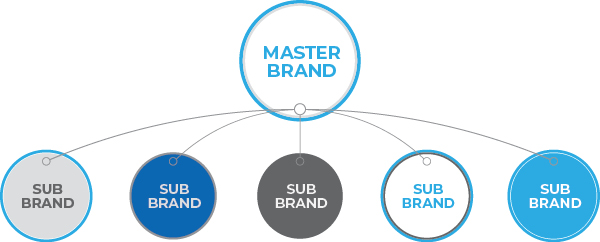What is Brand Architecture?
Brand architecture describes the way sub brands sit in relation to the parent brand within the broader organisation.

Brand architecture describes the way sub brands sit in relation to the parent brand within the broader organisation.

Brand architecture describes the way sub brands sit in relation to the parent brand within the broader organisation, their relationship to one and other and are used together. It provides a structure in which the brands sit.
Brand architecture generally falls into one of four categories: ‘Branded House’, ‘House of Brands’, ‘Endorsed Brands’ and ‘Hybrid Brands’. Let’s take a look at each structure with some examples:
Examples of ‘Branded House’ (also known as ‘Product Dominant’) brands include Apple and Google, with each sub brand usually adopting a derivative of the main brand, such as Apple iPad, Apple iPhone or Google Cloud and Google Maps etc.
A Branded House structure is when the master brand is prominent, well established with customer loyalty. These are circumstances under which a consumer will happily adopt the sub brand because of the standing and trust of the master brand.
An example of ‘House of Brands’ is Unilever. Unilever Australia has sub brands that including; Lynx, Lipton, Dove Streets, Continental and Bushell’s. In this situation the master brand has a lower profile, and in some cases might not even have a visible presence or be known to consumers, instead just operating from an organisational perspective.
The diversity of the sub brands deliver on their own messaging and benefits to consumers. This means the master brand is not as important.
‘Endorsed Brands’ offer a compromise between Branded House and House of Brands structures. Sub brands have greater flexibility in messaging, positioning and appearance. They can still draw on the prominence and equity of the master brand.
Examples of Endorsed Brands include Nestle Milo, Sony PlayStation, Bingle Underwritten by AAMI and Polo by Ralph Lauren.
As the name suggests, ‘Hybrid Brands’ are usually a mixture of brand architectures. They often result when a company changes structure or acquires a new brand.
This structure keeps the original name which the market understands and allows for a new brand structure.
Hybrid brands can take on the style of the parent brand to subtly associate the sub brands without overly referencing the master brand. Examples of hybrid brands include Amazon with its sub brands ‘A9’, ‘amazon.com’ and ‘IMDb’, all of which employ the same colour palette and similar styling cues to the master brand. Microsoft employs a similar approach with its ‘Office’, ‘Windows’, ‘XBOX’ and ‘bing’ sub brands.
The latest industry news, interviews, technologies, and resources.
Due to complex stakeholder relationships, B2B marketing for large building companies and industrial construction leaders can be challenging. Knowing what drives and motivates decision-makers and key opinion leaders (KOL) is crucial.
Read postI.M.A are proud to have given our support and resources to launch a funding drive for nurses at Campbelltown and Camden Emergency Departments to participate in the Advanced Paediatric Life Support training program.
Read postWe’re all ears, and we’re here to help you grow your business.